This Small Coastal Village Deserves Your Attention: Impressive Ancient Viewpoint and Fine Maritime Nature Trail Await in Pohja
In Commercial Collaboration with Visit Raseborg
Nestled by the sea in Raasepori, the small church village of Pohja is an excellent destination for enjoying the winds of the South Finnish coast. We arrived to explore the treasures of Pohja on an October afternoon, as the rain front was receding and the lovely autumn sun was taking over. We discovered a wonderful coastal walking trail, a medieval stone church, and an incredibly beautiful rocky hill in the middle of the village, which has a Bronze Age ancient burial site with a breathtaking view.
Pohja’s church village spreads at the bottom of a narrow sea bay, beautifully located by the sea. It’s about 80 kilometers from Helsinki and 100 from Turku. Trains from both cities go to Karjaa, from where a local bus takes you the last 10 kilometers to Pohja.
Although the buildings in Pohja are relatively new, its core offers beautiful glimpses far into history. A medieval stone church guards the landscape, on the other side of which rises an impressive ancient burial site, the tall and stone-gray Kasberget.
Gumnäs Nature Trail Leads Straight to the Seashore
Pohja also has an enchanting nature walk that leads not only through beautiful forests but also into fresh maritime landscapes. The Gumnäs nature trail (3,8 km) starts from Pohja’s dog park parking area near the center and is partly a loop trail. There’s also a map of the trail at the starting point, a picture of which is available here.
As a tip right at the beginning, if you’re here in the summer, definitely pack some snacks and swimwear!
We left the car in the parking lot on an October weekday evening and set out peacefully to explore what the trail has to offer. It was already quite chilly, as the wind made the already cool weather feel even colder.
The fragrant coastal forest quickly embraced us, the wind rustling its foliage. A picturesque smooth rock rose beside us, and the landscape soon became very naturally beautiful after the beginning. A simple bench had also been made on the rock, where it was nice to sit down right at the beginning to admire the sea view over the reeds and calm the mind for the hiking mood.
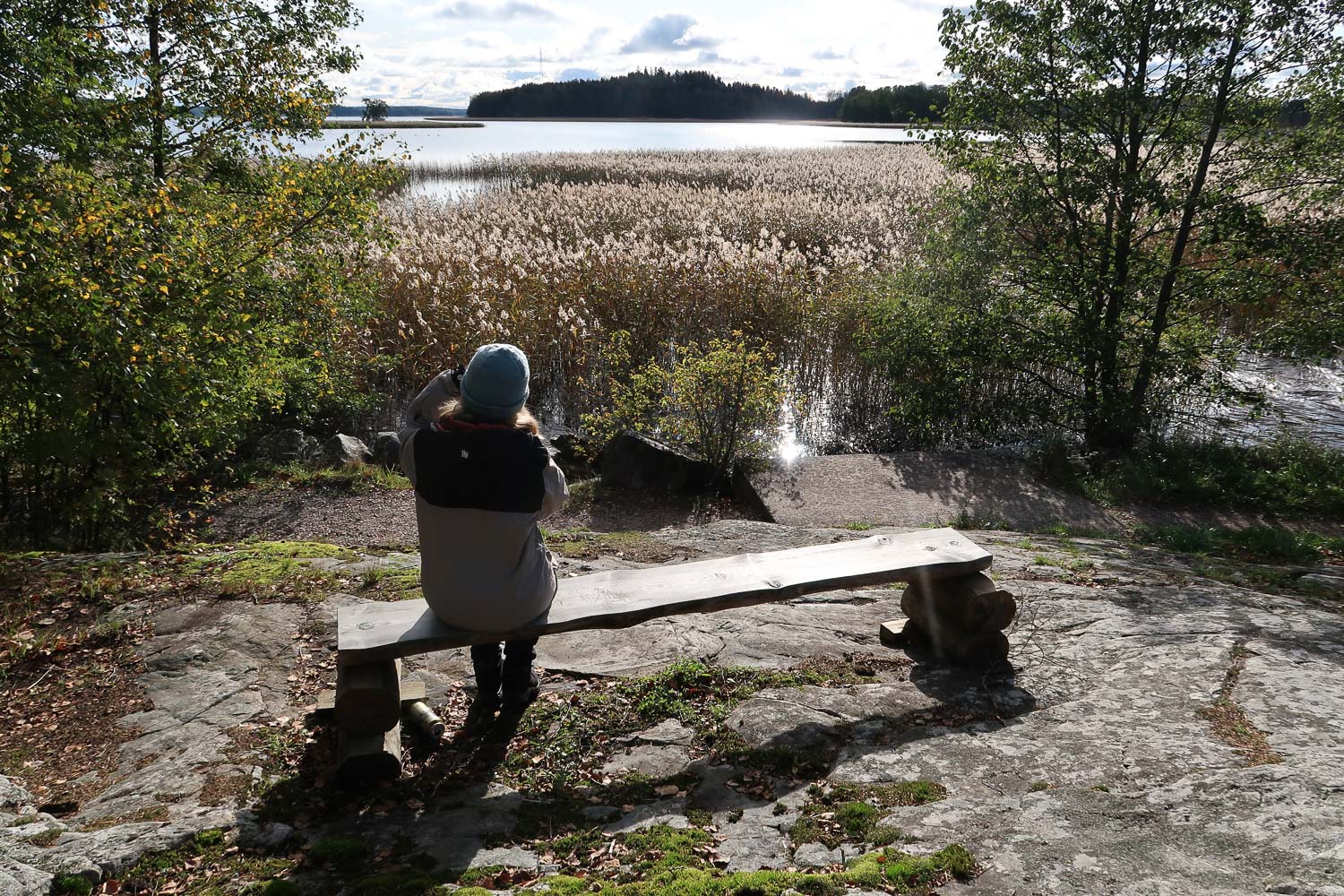
Throughout the journey, the trail is marked with small but clear signs. At intersections, the sign also has an arrow indicating the correct direction. The signs are easy to follow if you are even slightly attentive.
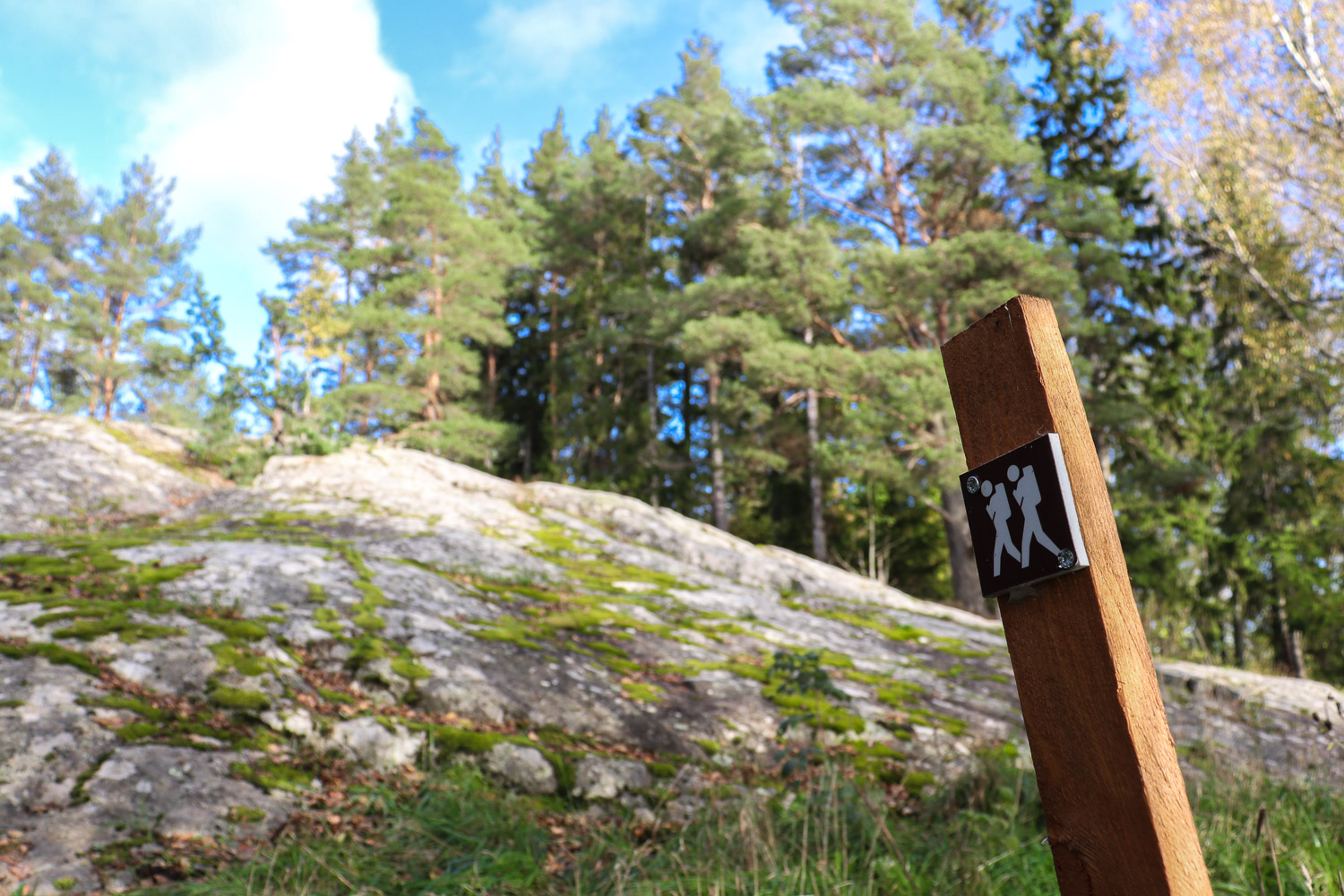
Along the early part of the trail, there is one wooden staircase, and in the same areas, the Gumnäs nature trail begins to overlap with the local frisbee golf course.
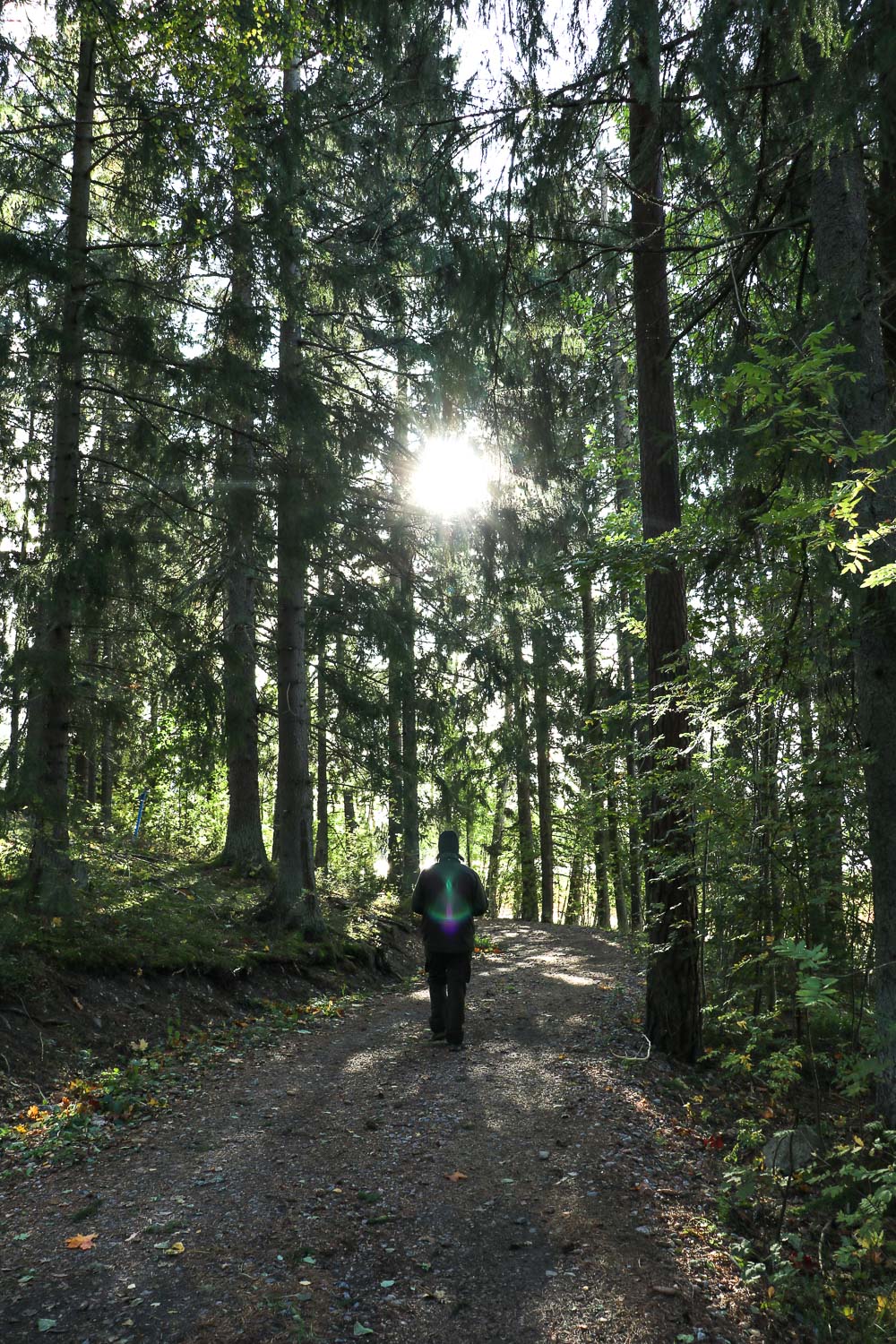
In addition to the needle path, the trail sometimes runs along small dirt roads, but only for short bursts. The overall atmosphere throughout the trail is very close to nature and peaceful.
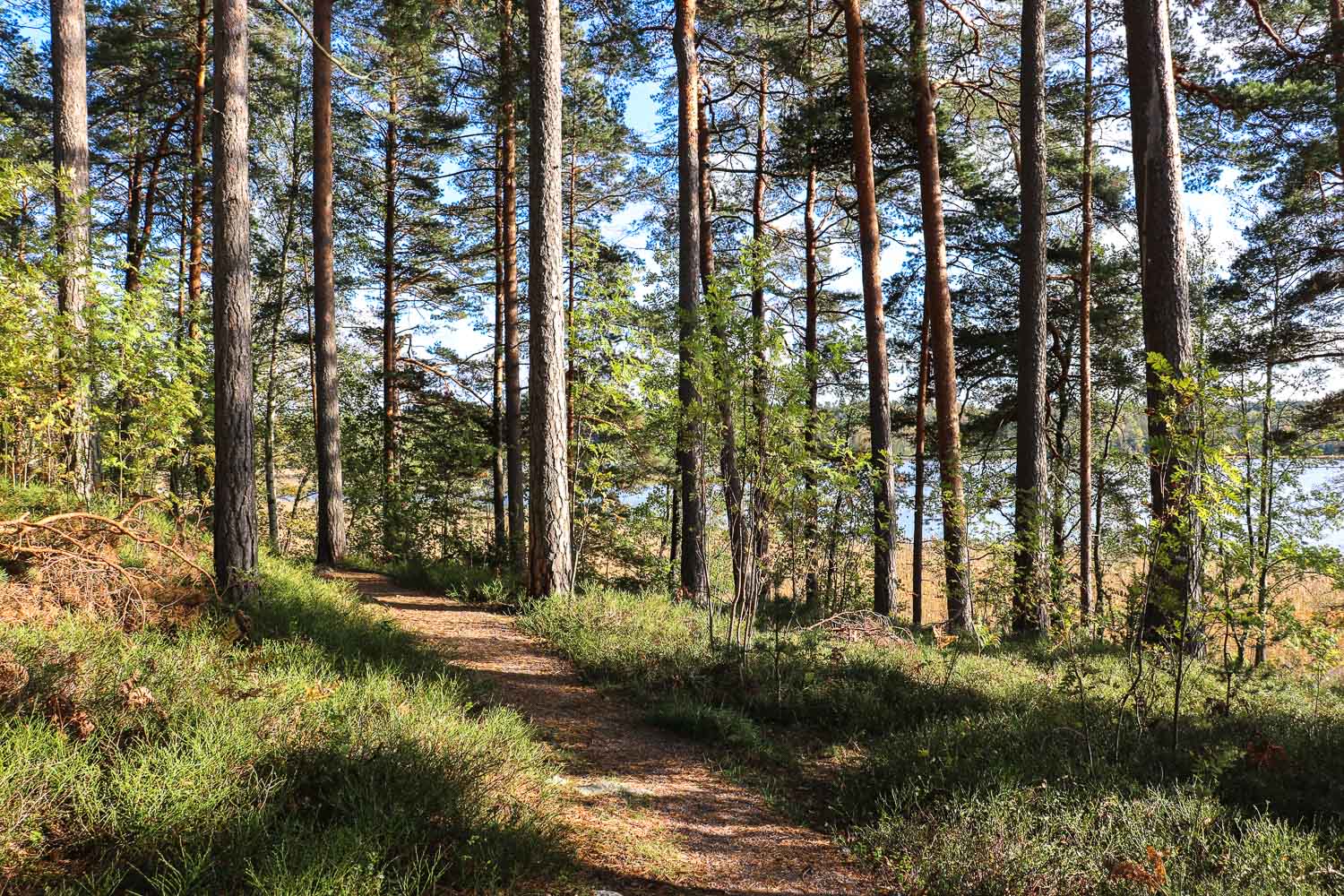
Our journey passed by a boat dock and a dance floor rising higher up on the slope. This is Gumnäs’ celebration place, which anyone can rent for their use. A pine forest rose majestically around us and hummed atmospherically in the sea breeze. Lower down on the shore, a beautiful and intact reed bed rustled, and last weekend’s autumn storm seemed to have brought reeds to the shore as well.
The trail was flat to walk on, as for most of the journey. It is actually gravelled, but the needles have already well covered it in many places.
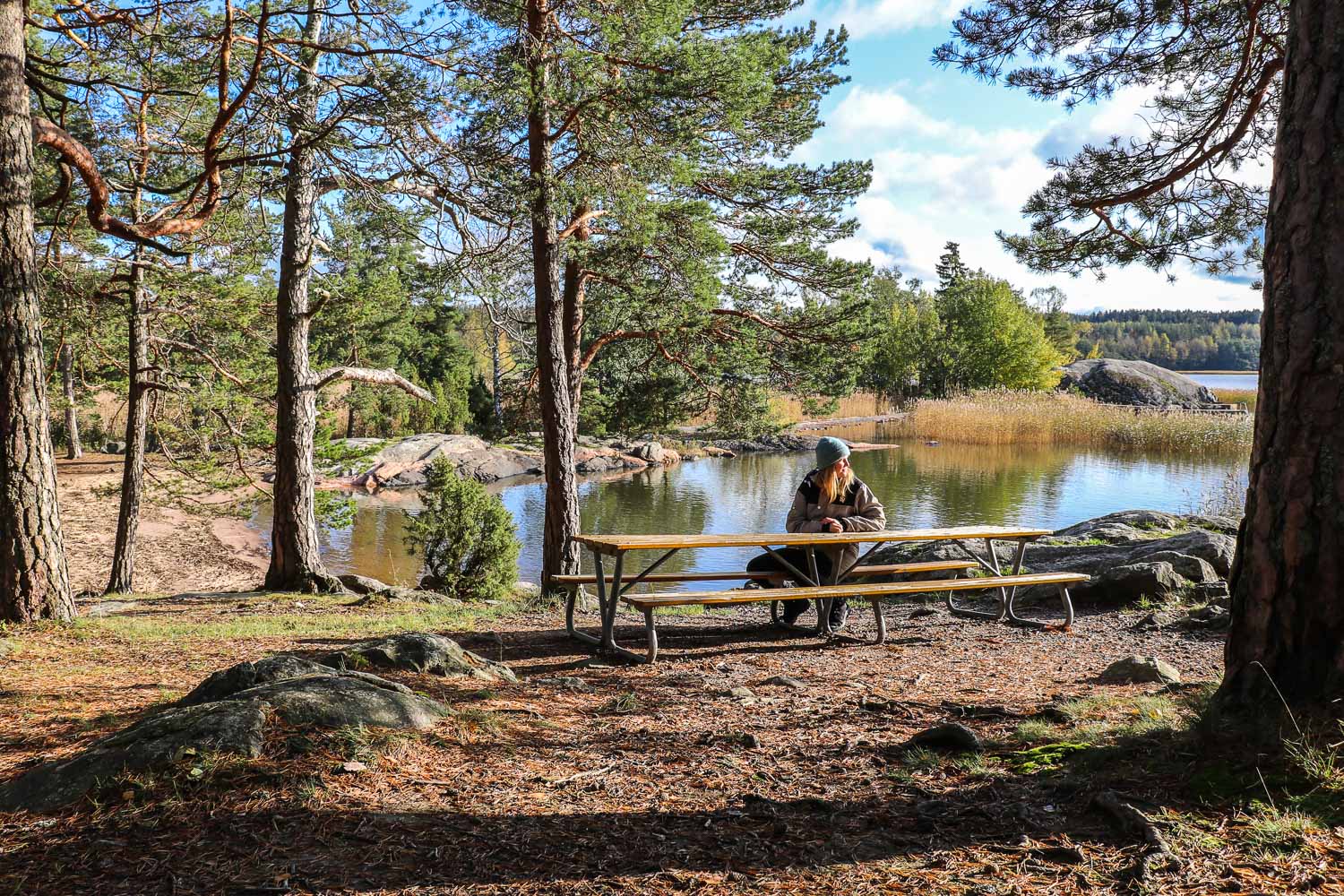
We arrived at Gumnäs beach, which was deserted in the cold October wind. The beach is small and really charming, with a curved fine sandy beach section and rocks. A table group (pictured above) facilitates eating snacks and also just offers a place to sit, and in addition, there is a neat outhouse and cute wooden changing rooms on the beach.
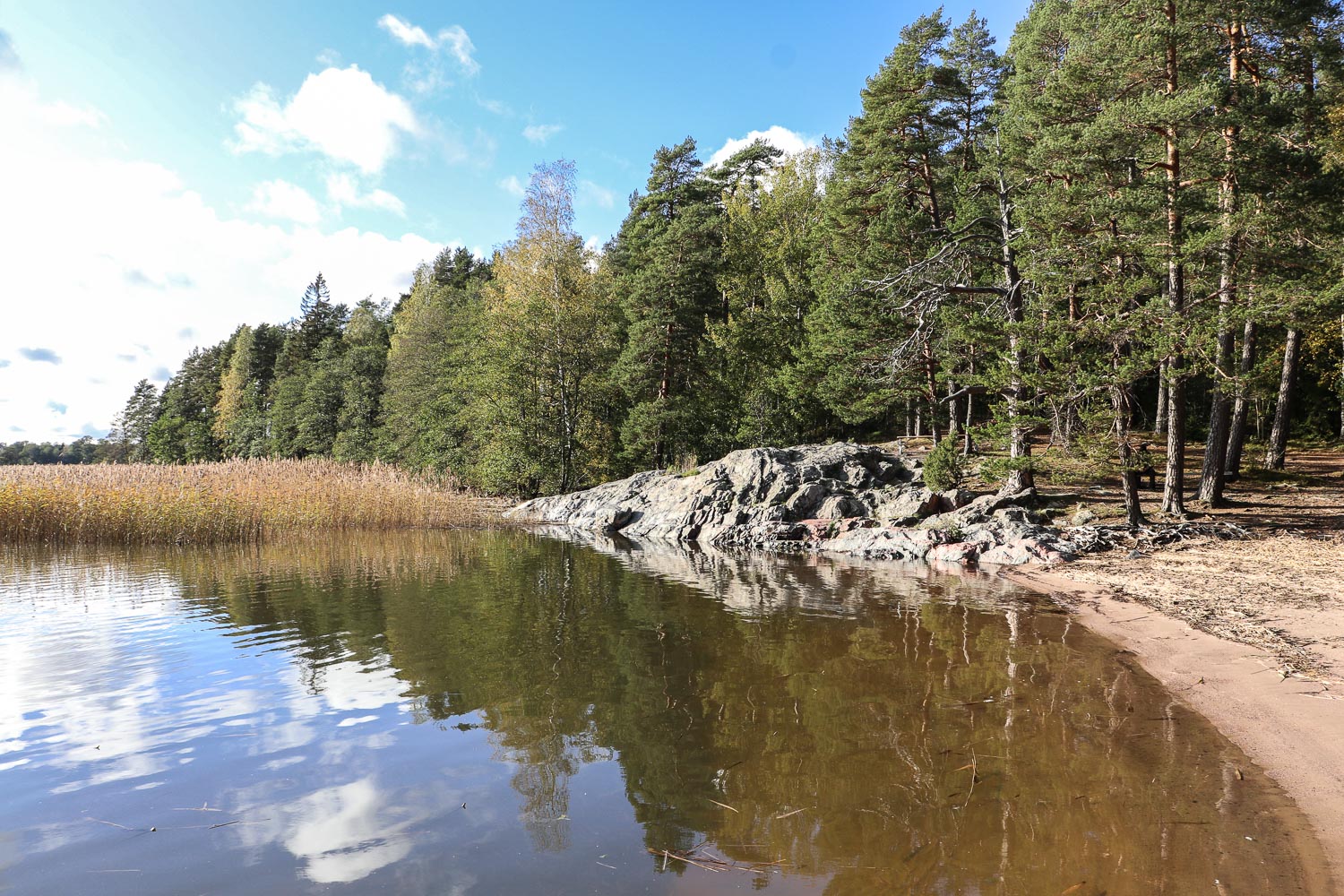
The beach is located in such a sheltered place that the water here was calm, even though it was windy further out at sea and higher up in the trees.
Beyond the beach in the direction of the sea, a magnificent and high smooth rock peeked out from behind the reeds (pictured below in the background). The actual Gumnäs nature trail does not lead there, but from the map board on the beach, you can see that it’s also worth a visit.
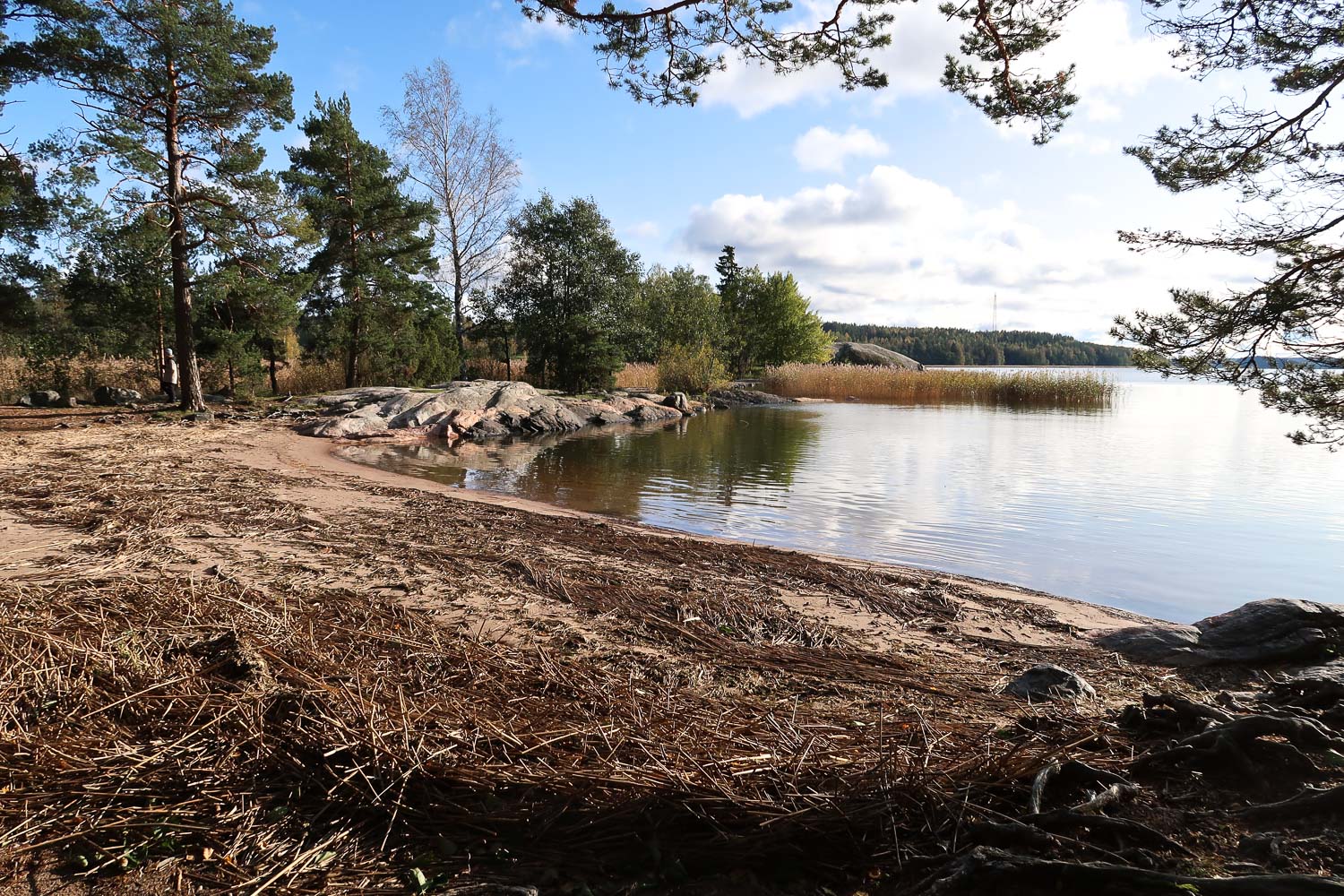
A built causeway led us to Klobben, a small islet where a high rock is located and also has a dock on its side.
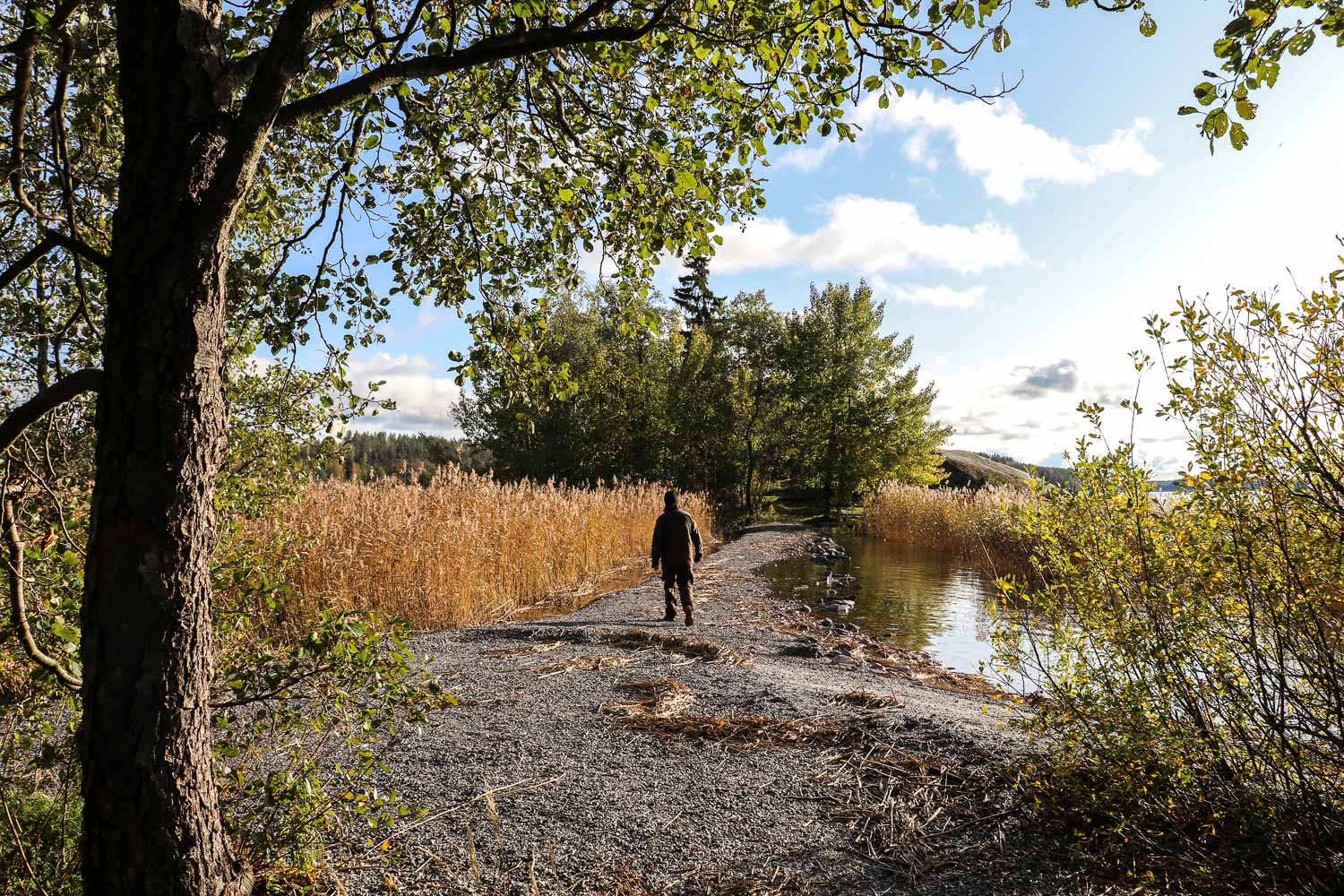
The dock is nice, and at the end of it, there are stairs – clearly a great option for swimmers if you don’t want to go swimming from the sandy beach for some reason.
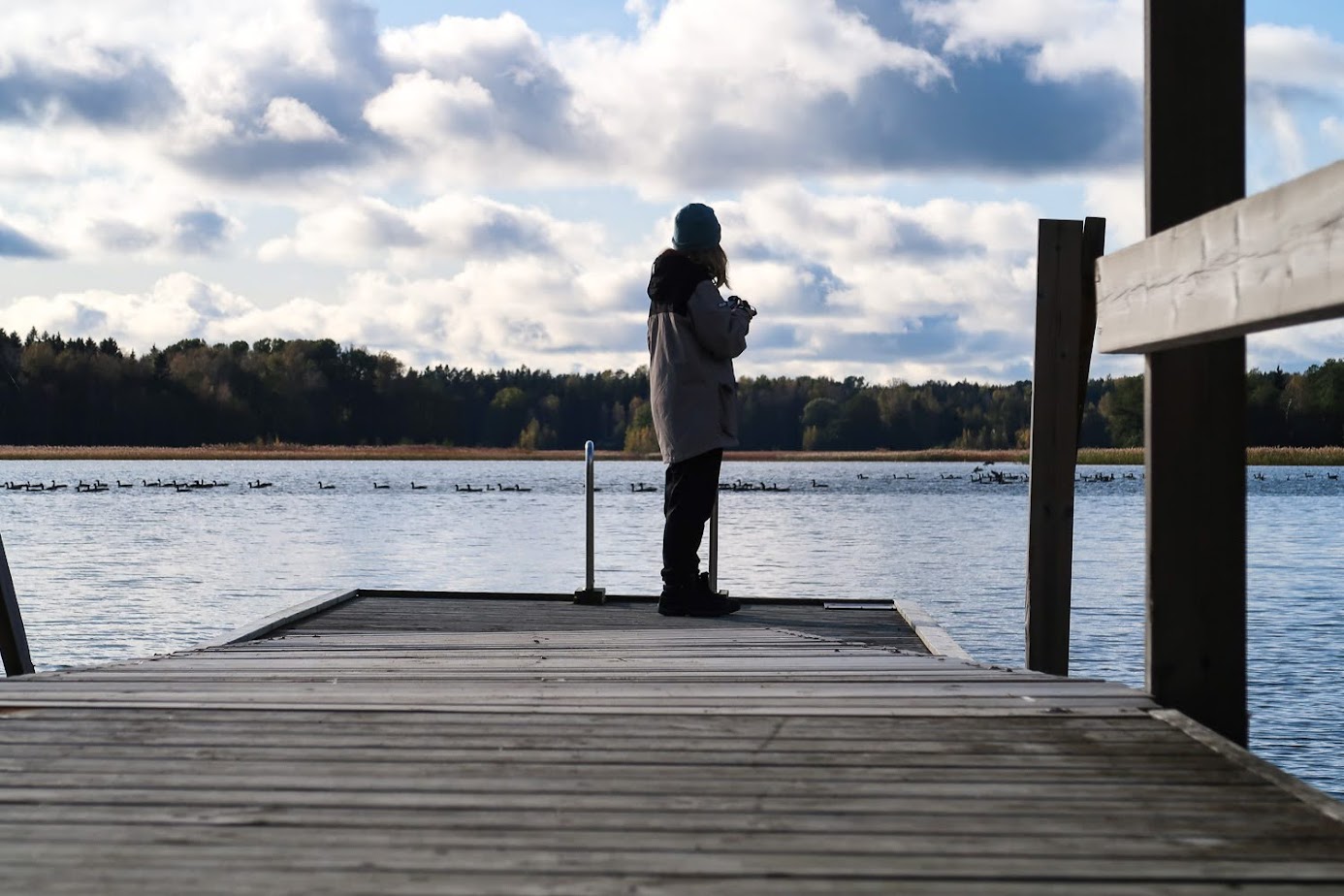
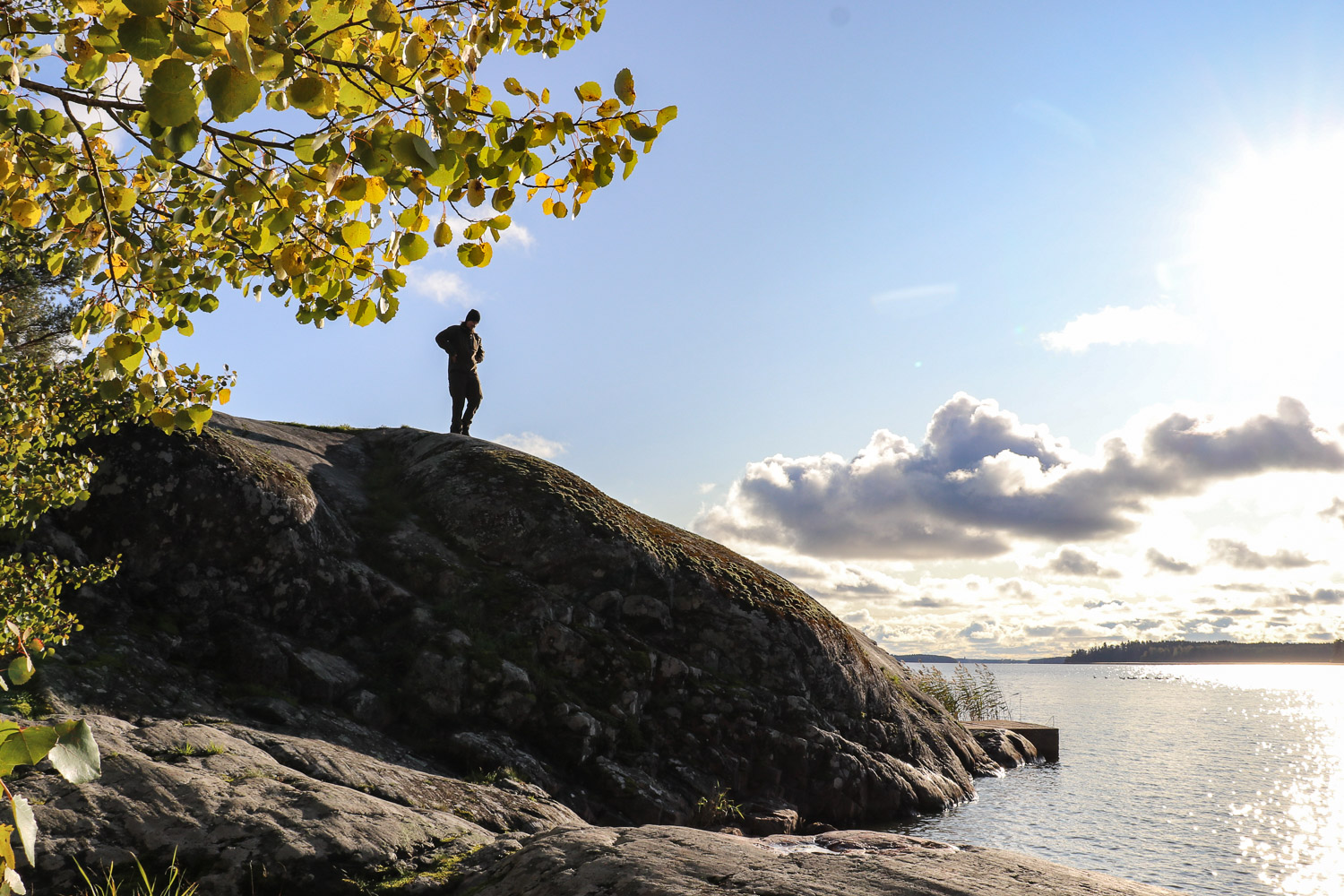
Returning from Klobben, the beach also looked different when the sandy cove was hidden in the embrace of rockier sections. The entire beach area is really charming; the people of Pohja have an exceptionally fine local recreation area here!
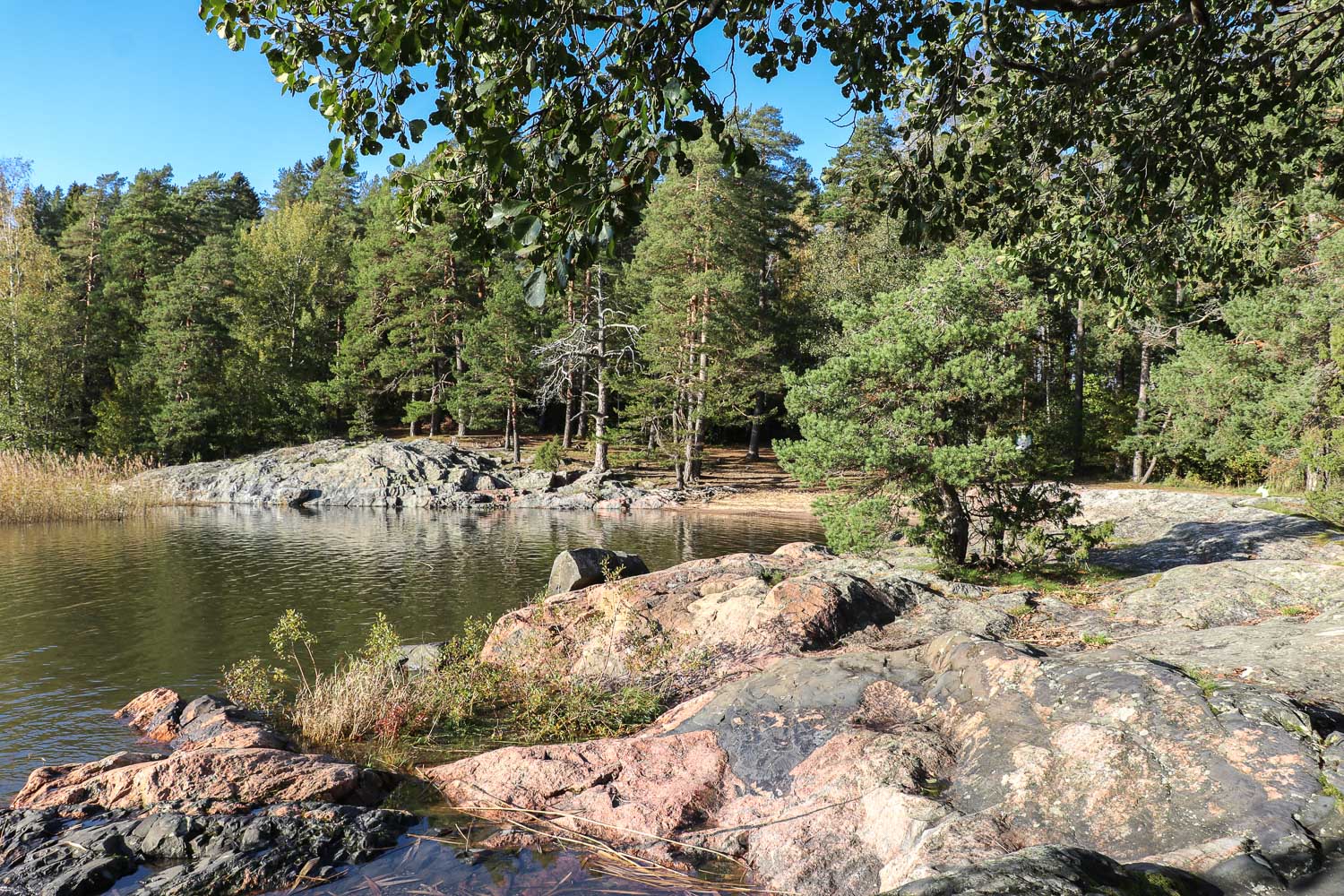
We continued our journey from the beach along the official Gumnäs nature trail. We navigated through the frisbee golf course by following the guide signs through a high spruce forest growing ferns towards the wooded cape on the east side of Klobben.
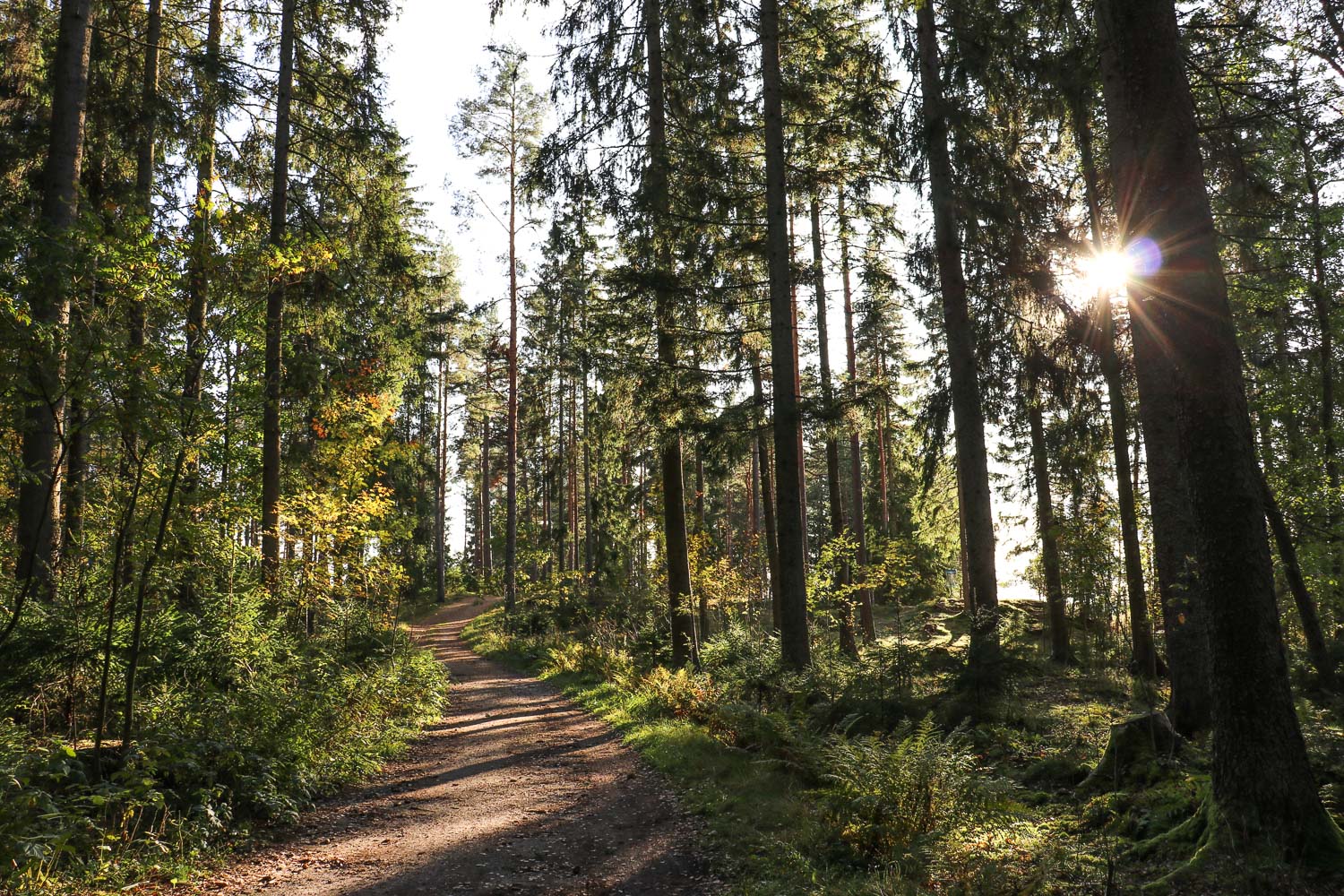
From the tip of the cape, we found a wide smooth rock with sitting benches – it seemed like a pretty perfect place to watch the sunset! If only we had some delicious snacks with us. Behind the bench, we found a fire ring with sitting benches. There were a few firewoods on site, but I recommend bringing your own wood if you plan to make a fire here. Making a fire at this fire place is prohibited when there is a forest and grass fire warning in effect.
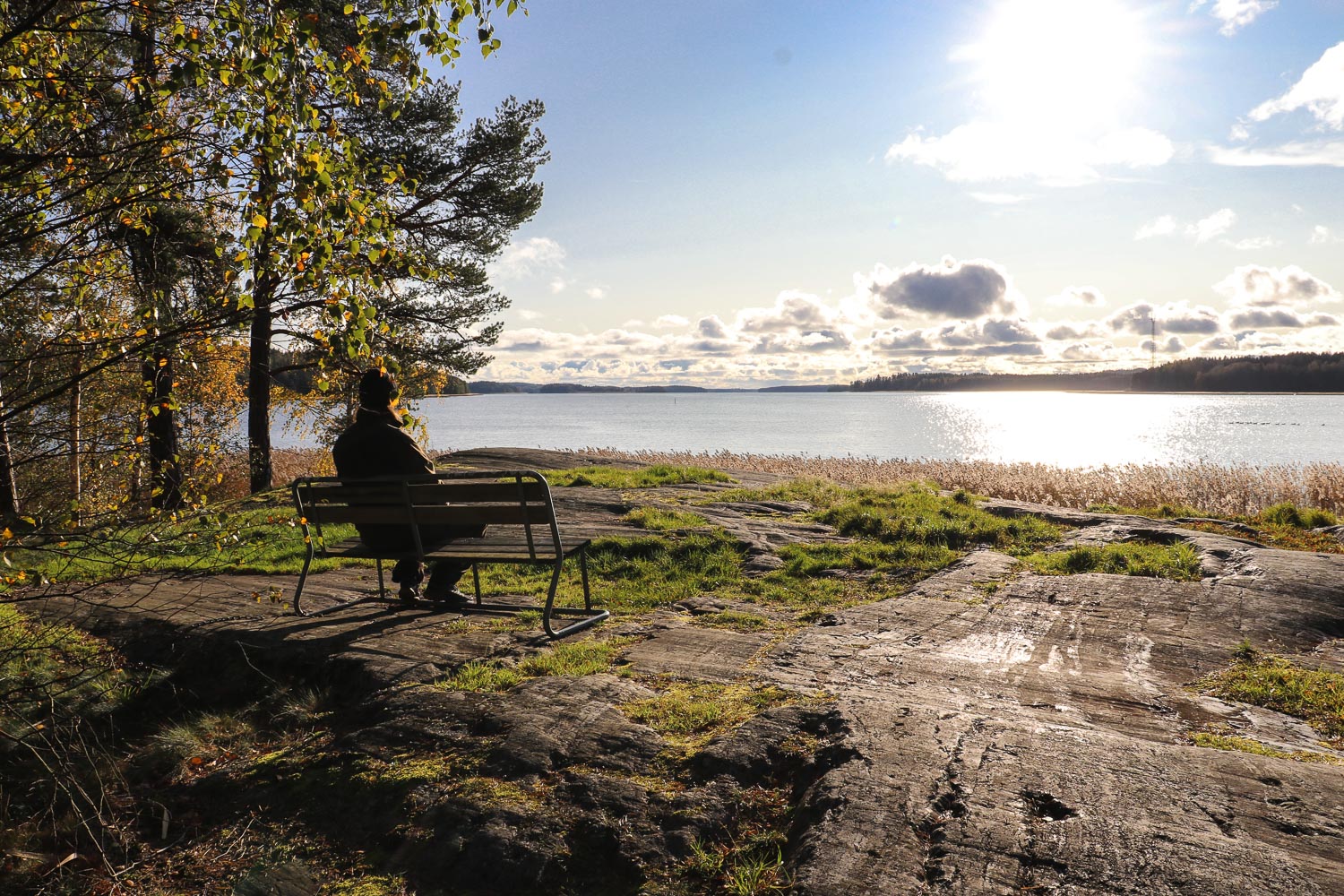
A small and inviting path led us away from the tip of the cape and soon joined a wider trail again. The journey went through a mossy, enchanting spruce forest, which does not appear to be a nature reserve on the map, but where fallen trees have apparently been left in place to rot and enrich the ecosystem. Wonderful! I love a forest that is allowed to live as it naturally would.
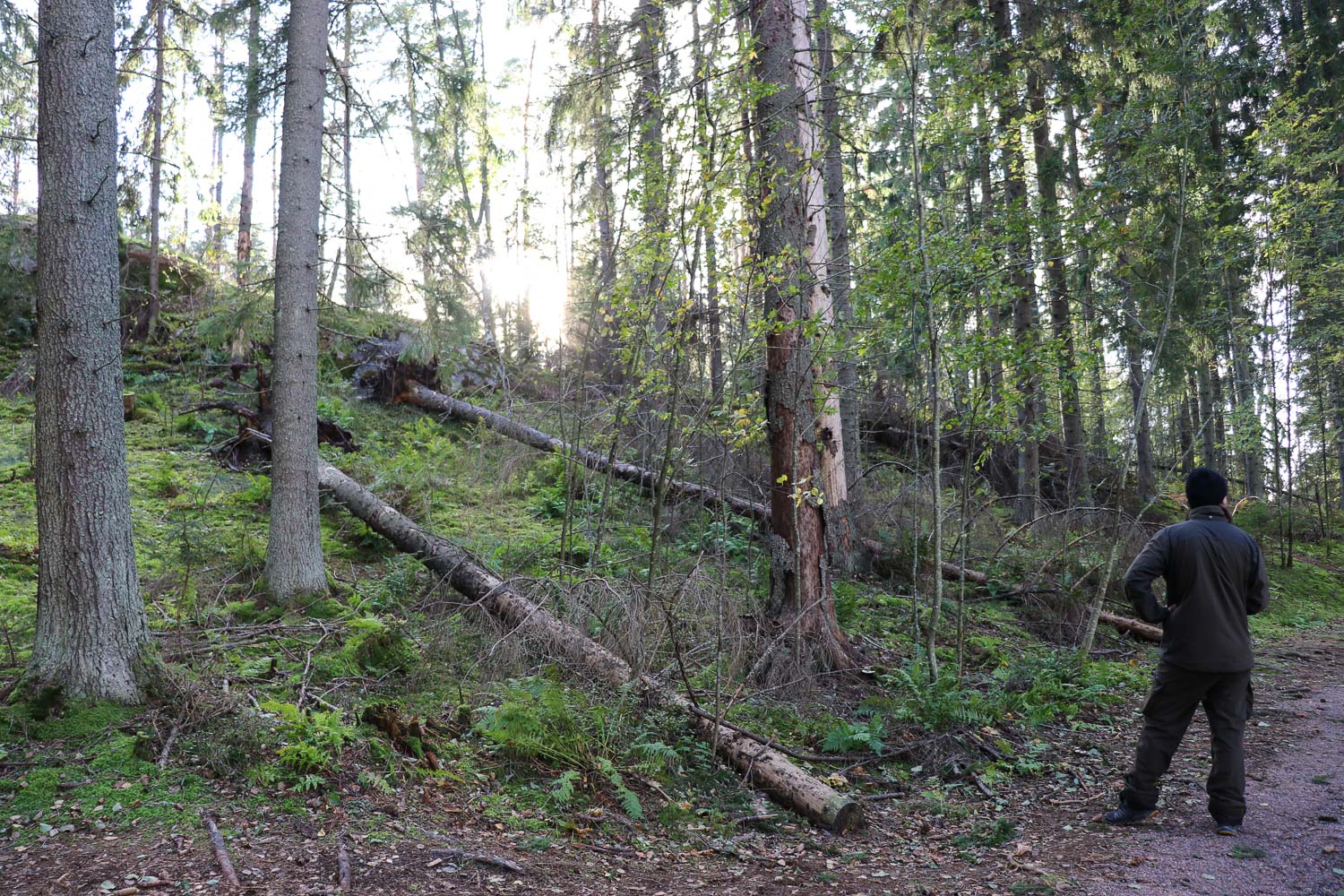
Soon after this, the trail returned back to the beach, and the rest of the journey back to the parking area continues along the same path as the beginning. Along the way, there were indeed a few very short dirt road sections, but we didn’t see any cars ourselves and it felt like there was hardly any need to worry about traffic here.
Church of St. Mary
Address: Vanha Turuntie 79, Raasepori
In the center of Pohja, my admiring gaze could not help but be drawn to the old stone church, whose variegated gable and beautiful shingle roof rose eye-pleasingly beautiful among the autumnal trees. As we got closer, I also saw a fine bell tower, which in yellow fit perfectly into the autumn landscape.
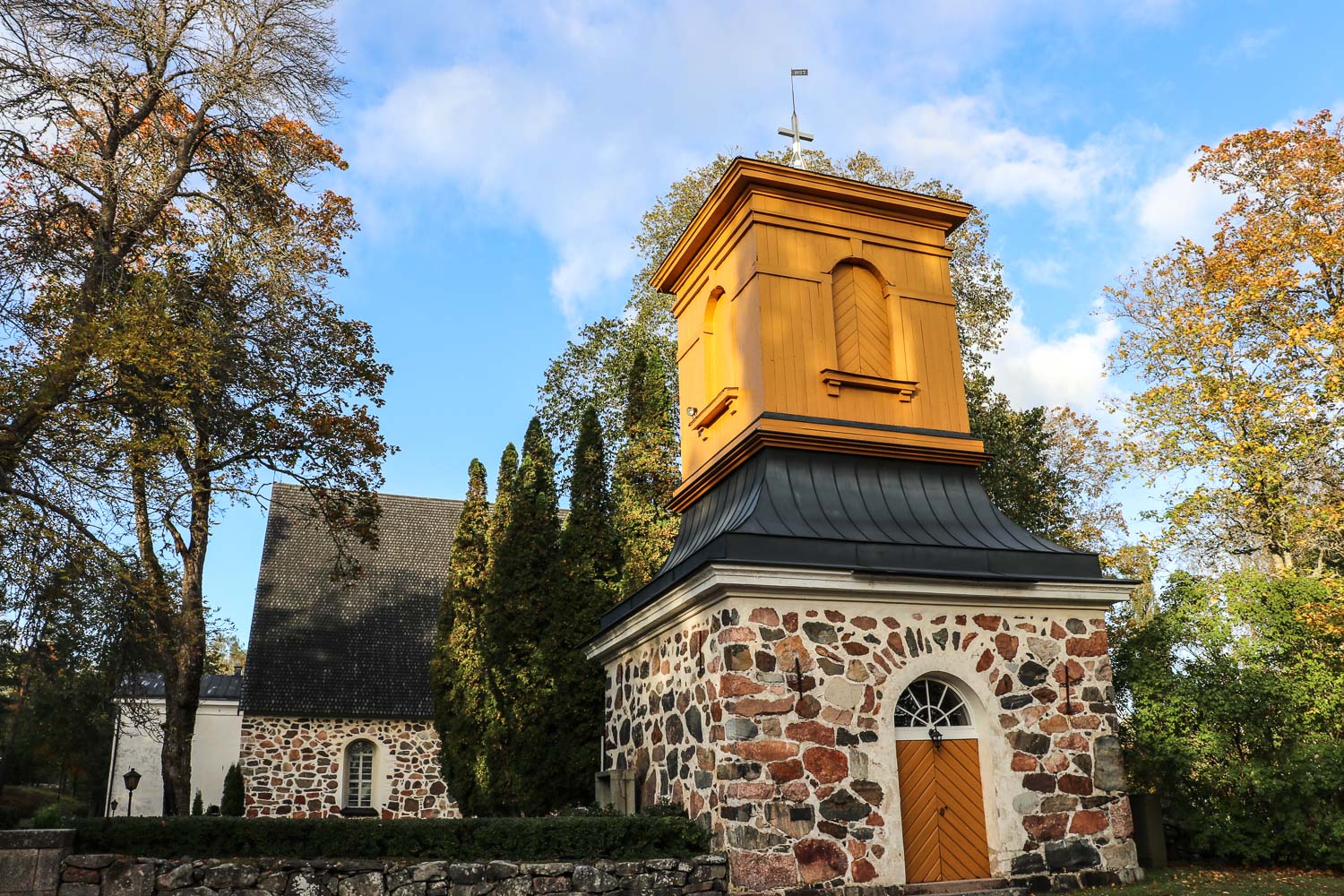
The church of Pohja is dedicated to the Virgin Mary, and it is also old: it is a medieval church, the construction date of which is estimated to fall between 1475 and 1480. It is also believed that there was a wooden church on the same site about two hundred years earlier, and that it has left behind a valuable wooden sculpture depicting Madonna and Child.
The church is open during events and by agreement, but even if you can’t get inside, it’s worth taking a quiet walk in its ancient, calming courtyard and cemetery.
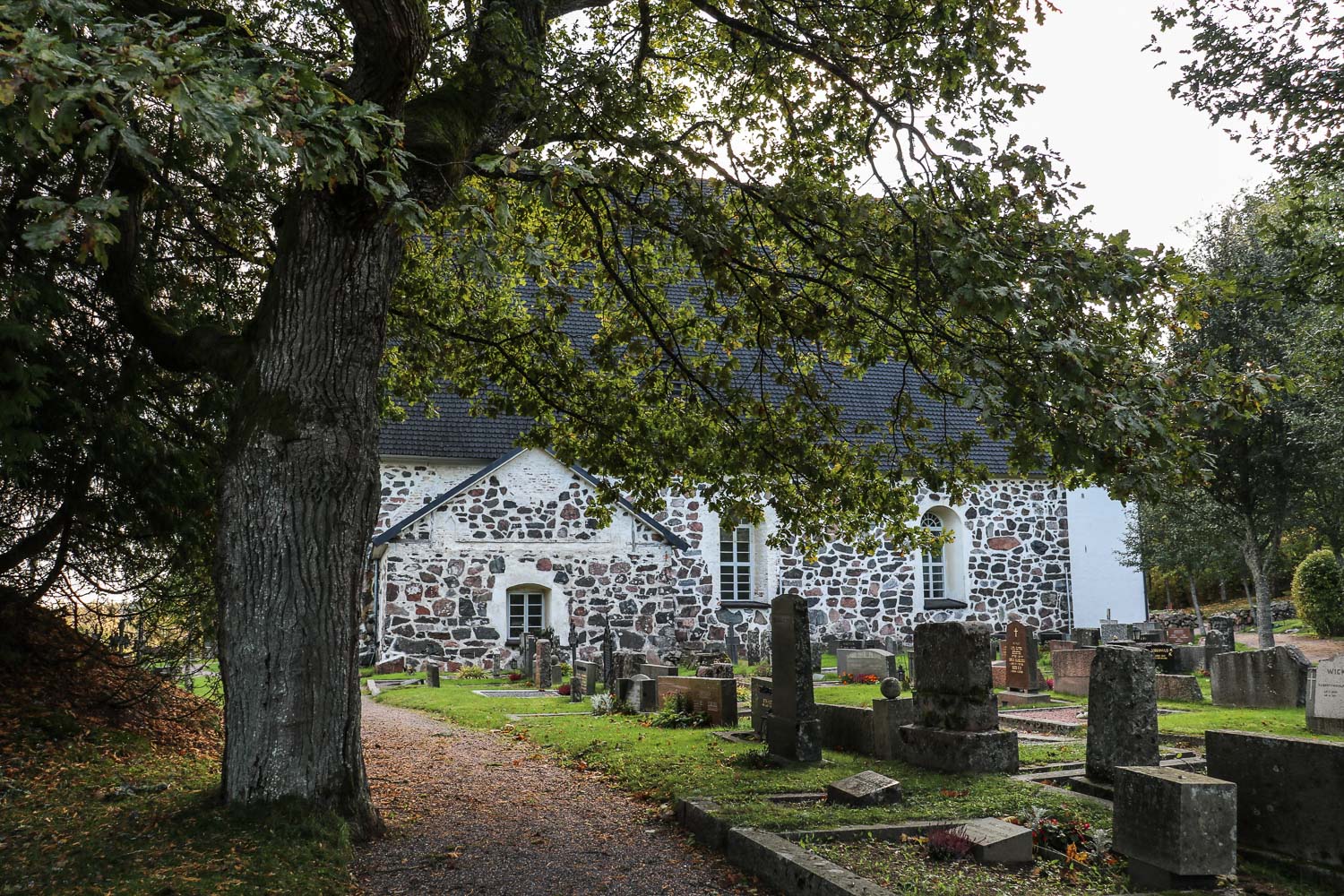
The cemetery is full of peace. The place is intimate and nicely sized, beautifully blending into the rest of the village and subtly reminding of the finiteness of life in a beautifully subtle way. Impressive-looking family graves, the beautiful roof of the church, and the framing grove attract attention.
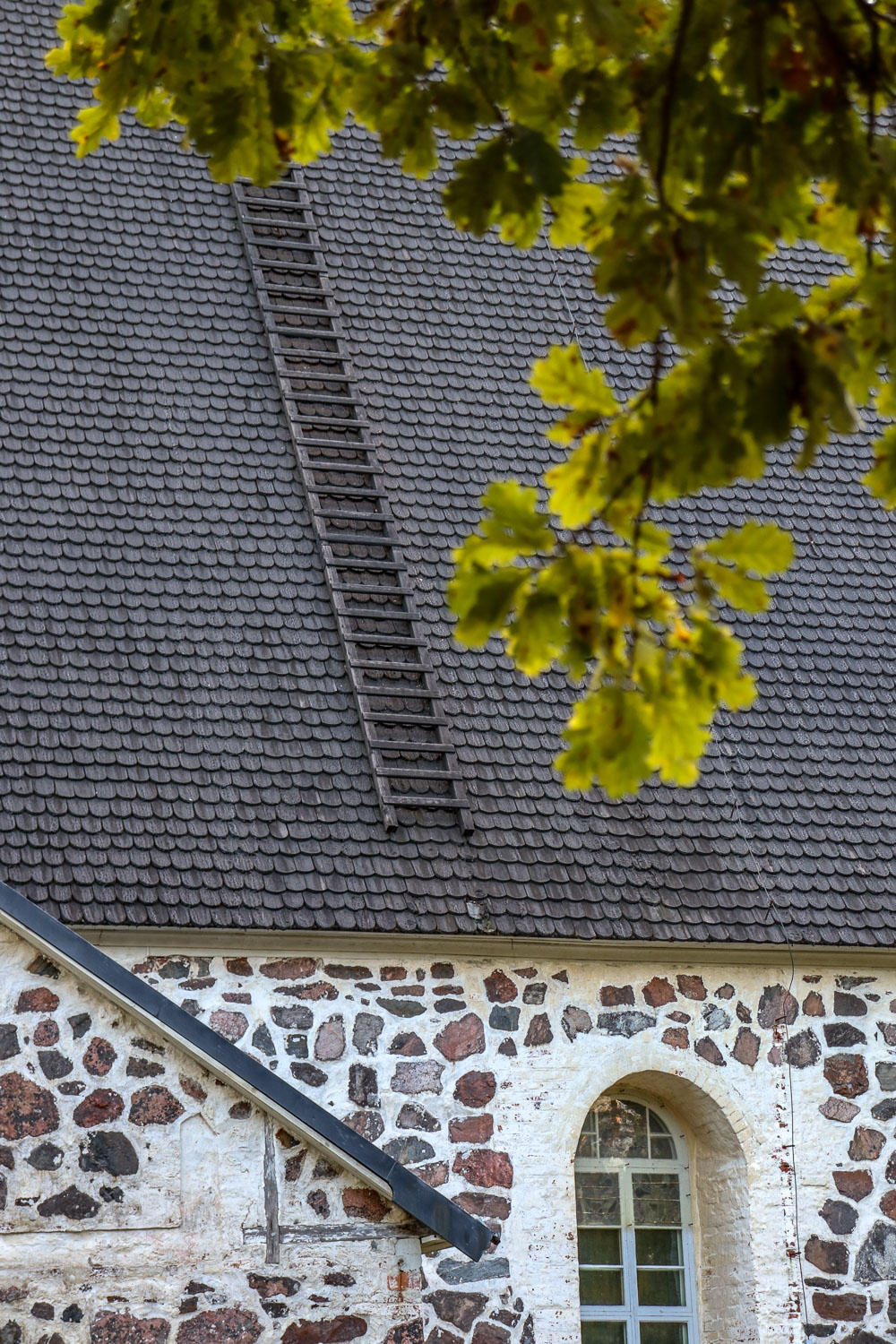
The church is wheelchair accessible.
Kasberget Crowns the Pohja Trip
Distance approx. 500 m/way (from the beginning of Kasavuorenkuja road)
No fireplace
By this time, we had already noticed the huge, gray-sided rock rising in the middle of the village. The impressive sight inevitably caught the eye, as even the ancient burial site on its top and the pine tree rising above it are clearly visible from the main street of Pohja village.
Near the center, a tiny road called Kasavuorenkuja rises from Vanha Turuntie road up the slope. If you are traveling by car, it is most convenient to leave it in the center – the walking distance is not long after all – but if the car’s off-road capabilities are good, you can drive up the narrow Kasavuorenkuja to the turning point if you wish. However, there is no guarantee of the condition of the road, and it does not lead all the way to the top either.
A sign from Vanha Turuntie Road directs to Kasberget. Encouraged by it, we started walking up the road between two home yards, and soon we were surrounded by beautiful coniferous forest again. A narrow path branched off from the road towards the top of Kasberget. We followed it, and right at the first steps, I regretted not bringing a bag for chanterelles on this trip.
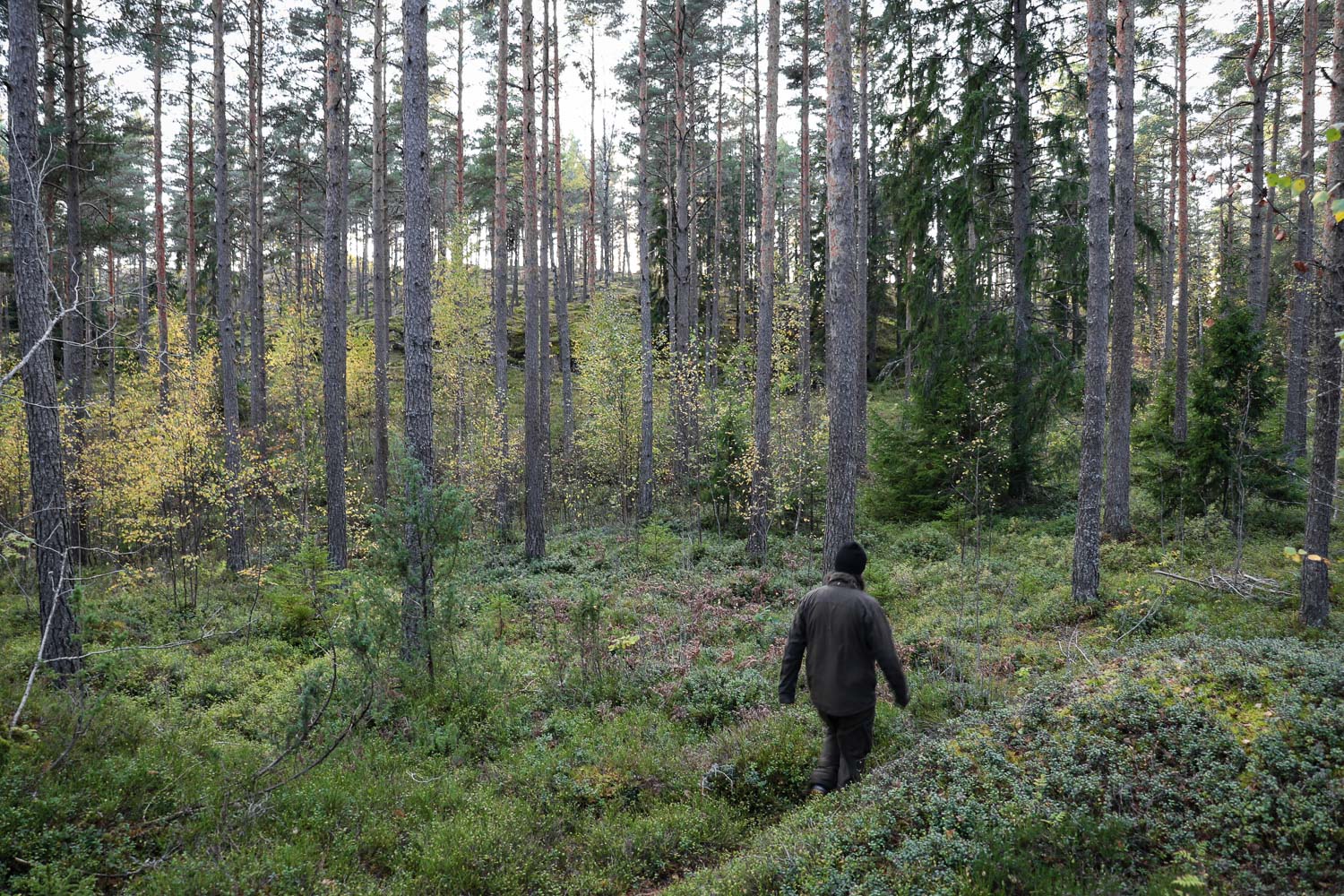
On the edge of the cliff, the sun shone brightly, so it was easy to know that the journey to the viewpoint across the forest would not be very long. However, the path was rooty and partly rocky, sometimes even a bit steep.
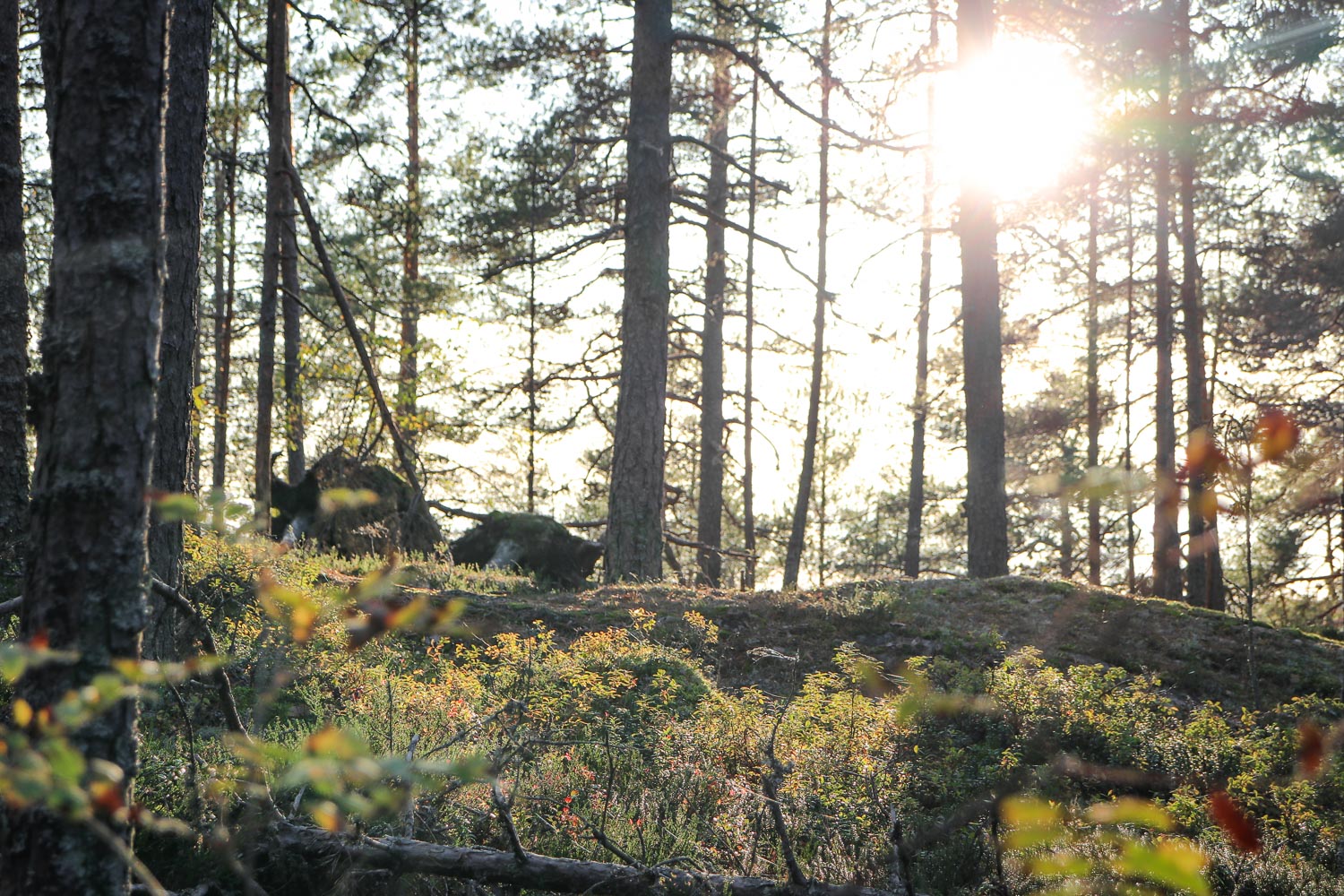
The top of the mountain was a magnificent sight. The sea was beautifully visible, as was the church from which we had just come. The rest of Pohja village spread out in our field of vision below us.
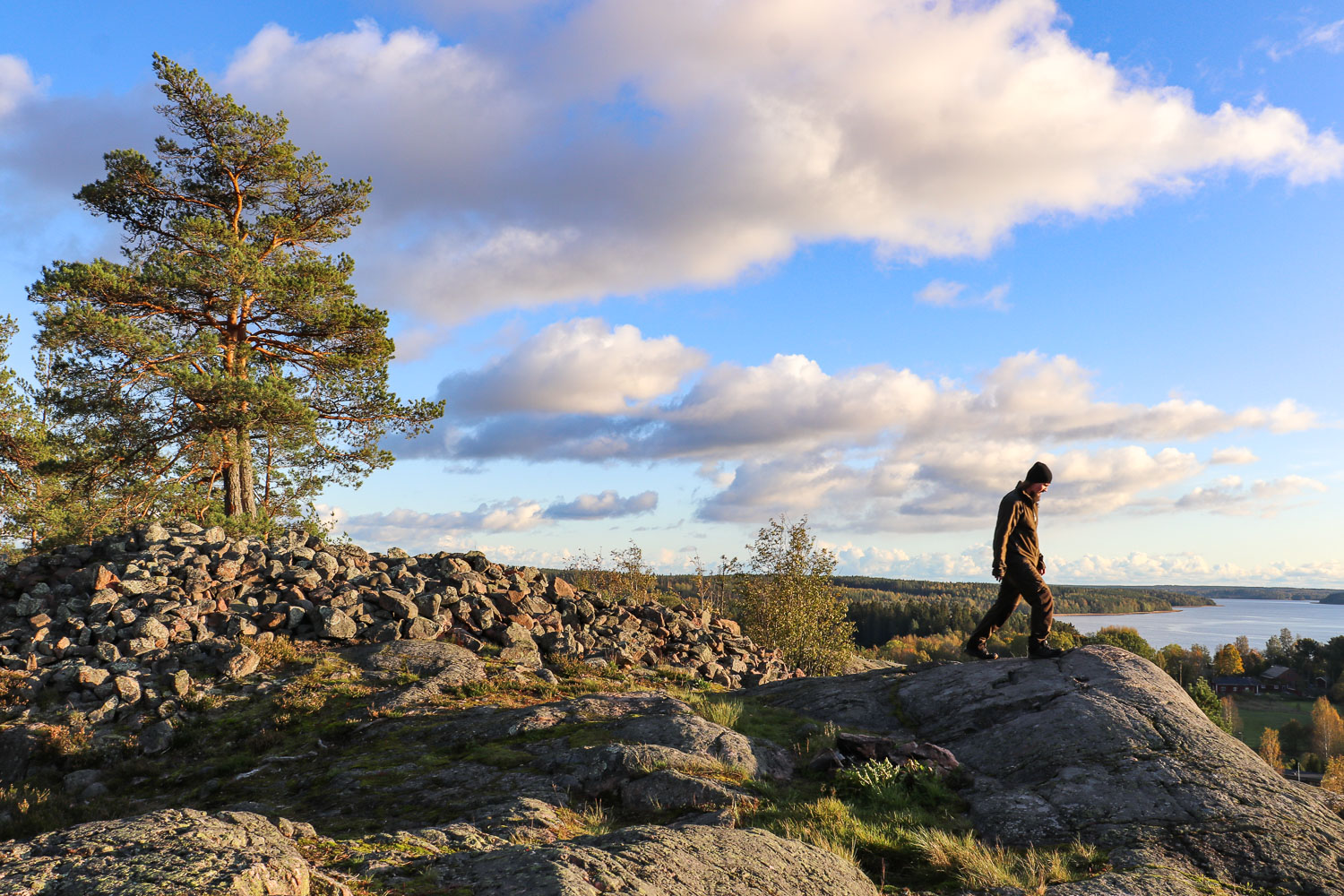
The ancient burial site on the top of Kasberget is from the Bronze Age. The Bronze Age was lived in the years 1700–500 BCE. At that time, it was customary to bury the deceased in such stone piles – sometimes they are called crowns, certainly based on their ring-shaped form and also because they often are located on the tops of high rocks – either as body or cremation burials. Naturally, one should not touch these graves and stone settings in any way, nor should one climb on top of them, as it is not appropriate to jump on top of any other types of graves either. Great respect and good manners should always be present when moving in nature and at old burial sites.
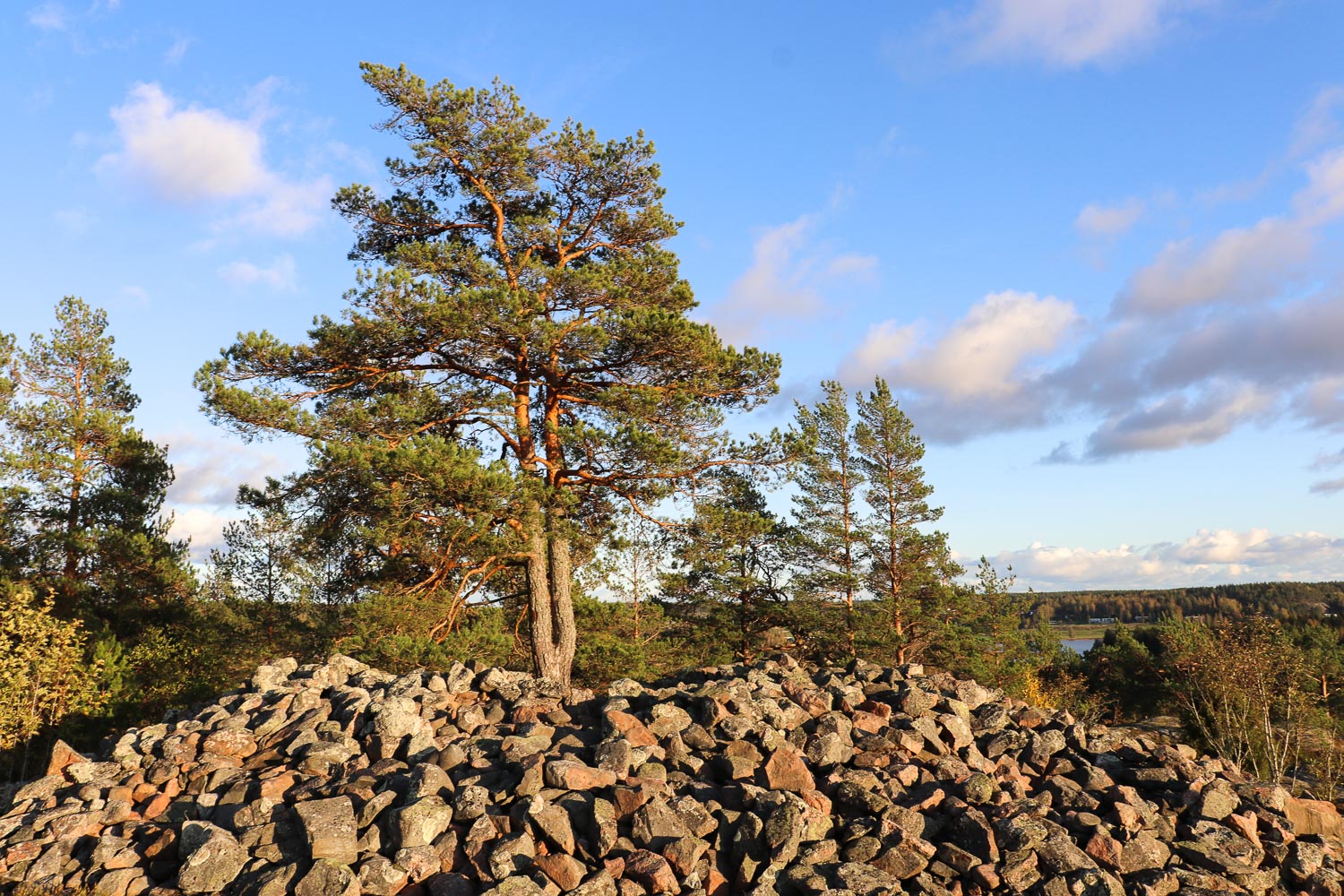
It is estimated that there are up to 3000 Bronze Age cairn graves on the Finnish coastal areas, so it is not a rarity, but I have to say that you don’t encounter such an incredibly beautiful scenic spot with a crown every day. In Raasepori alone, you can find at least six Kasberget-named peaks, so if you go to Raasepori just to see this place, be careful that your destination is specifically Pohja’s Kasberget.
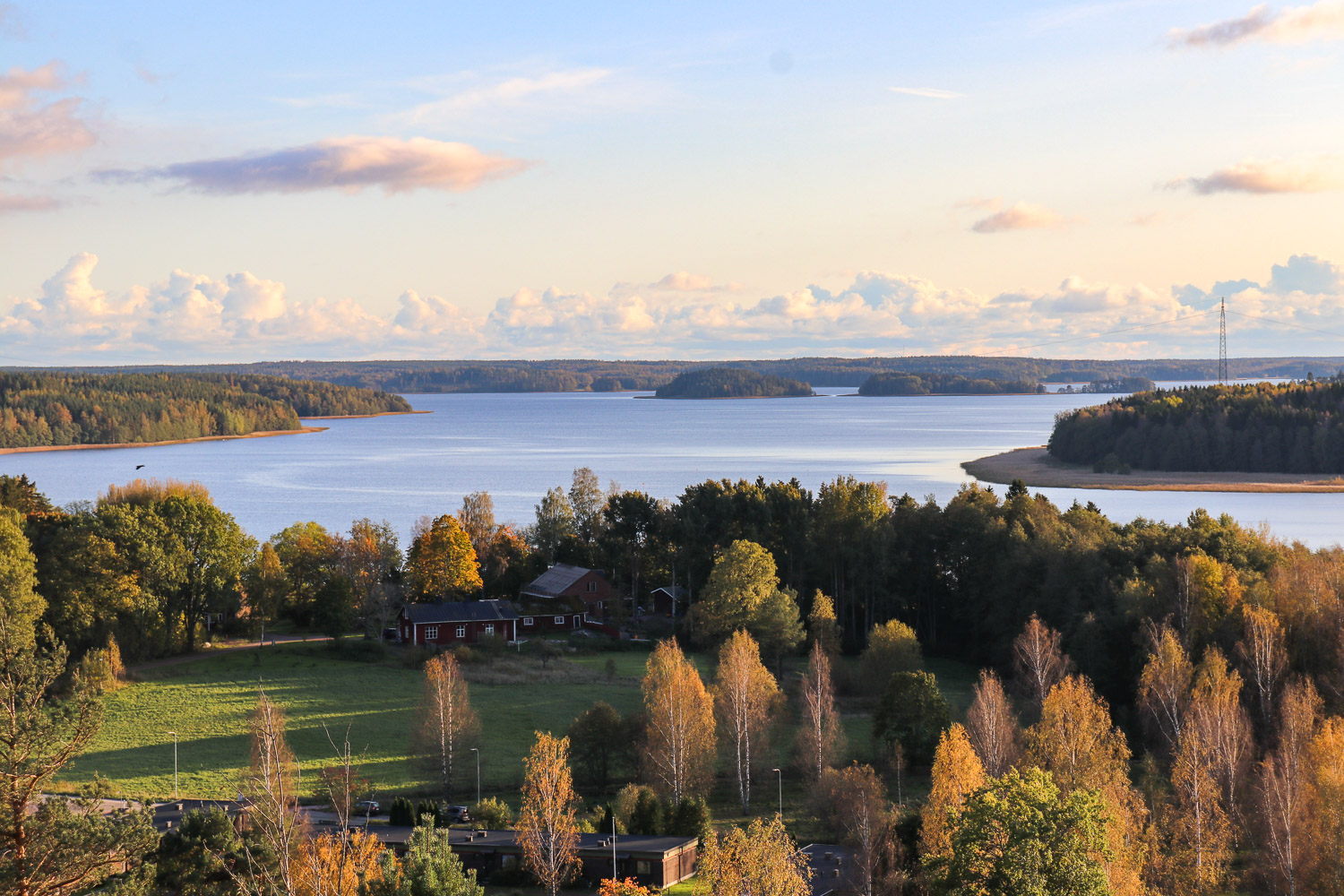
Several online sources report that the diameter of this well-preserved grave is 16–19 meters and the height is 1.7 meters.
We admired the landscape around us for a long time, as well as enjoyed the autumn evening sun and the fresh breeze. A snack break would have been in order at this point. I recommend that when you come here with your spouse, family, or even a friend, or why not alone in your own good company, bring coffee or tea in a thermos and perhaps cookies in a snack box, and spend a peaceful moment here on the top of Kasberget in a soul-soothing landscape.
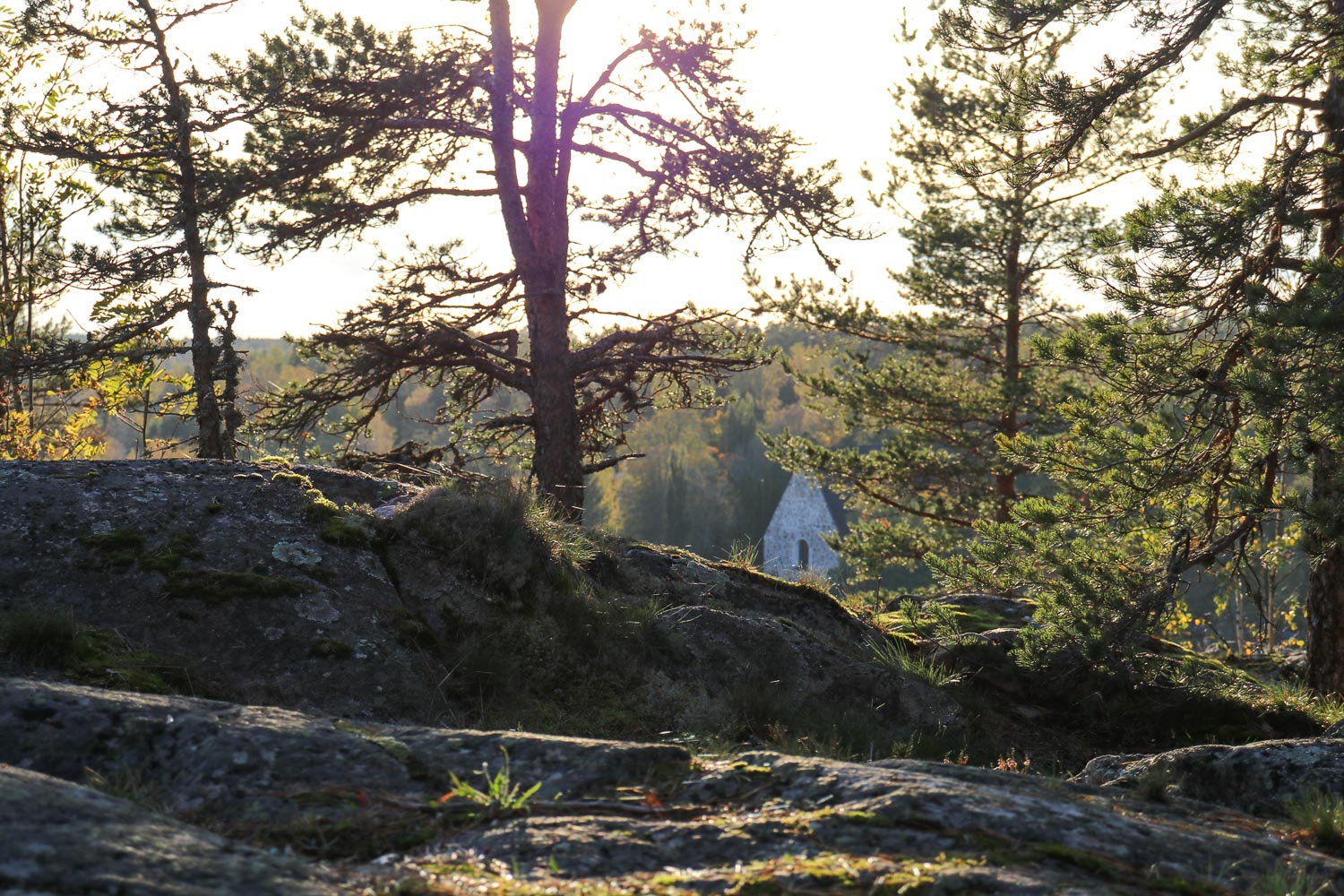

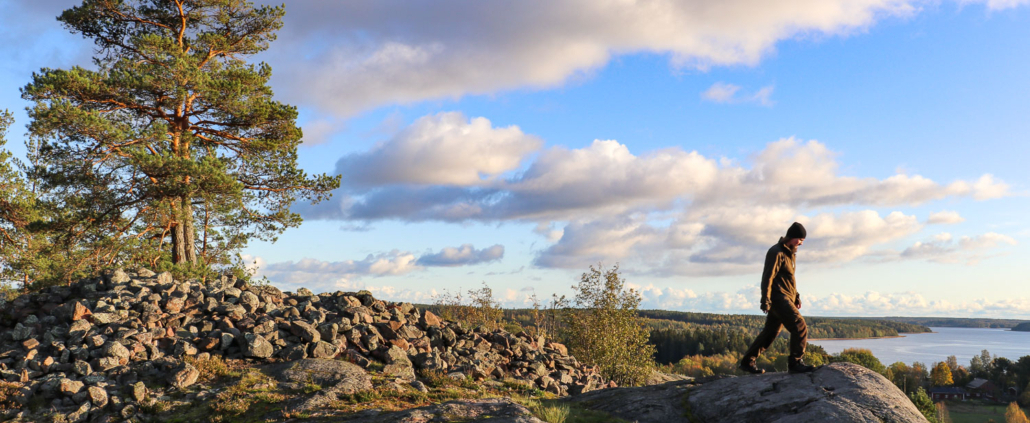



Leave a Reply
Want to join the discussion?Feel free to contribute!